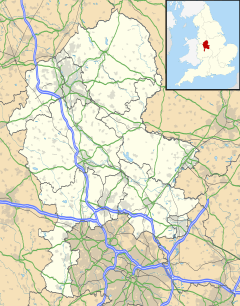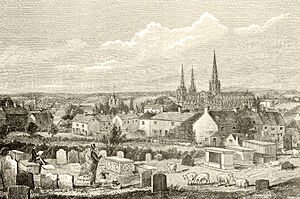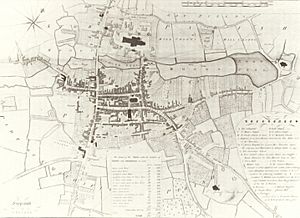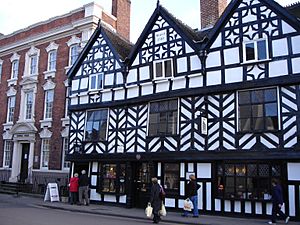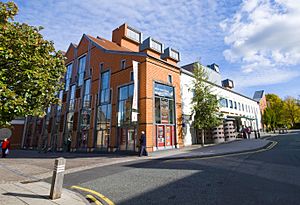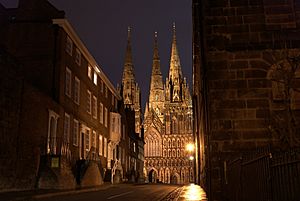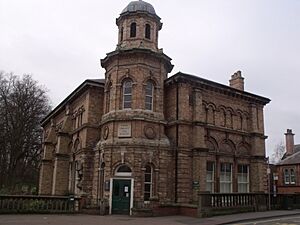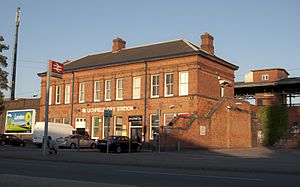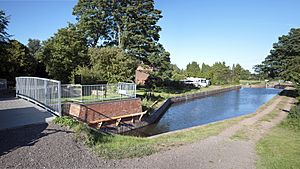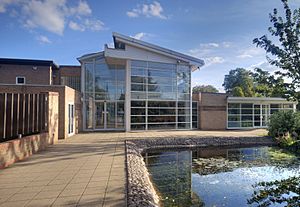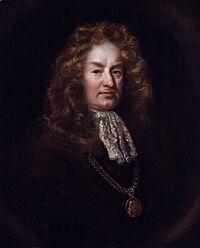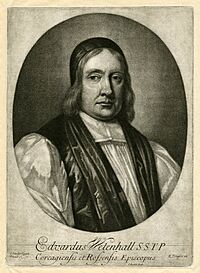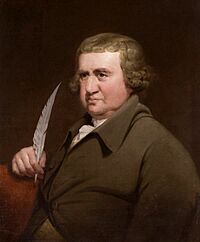Lichfield facts for kids
Quick facts for kids Lichfield |
|
|---|---|
| City and civil parish | |
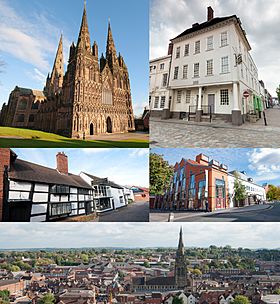 From top left: Lichfield Cathedral; Samuel Johnson Birthplace Museum; Quonians Lane; Garrick Theatre and skyline of the city. |
|
Coat of arms of Lichfield Motto: Salve, magna parens (Hail, great parent) |
|
| Area | 14.02 km2 (5.41 sq mi) |
| Population | 34,738 |
| • Density | 2,478/km2 (6,420/sq mi) |
| Demonym | Lichfieldian |
| OS grid reference | SK115097 |
| • London | 121 miles (195 km) NNW |
| Civil parish |
|
| District |
|
| Shire county | |
| Region | |
| Country | England |
| Sovereign state | United Kingdom |
| Post town | LICHFIELD |
| Postcode district | WS13, WS14 |
| Dialling code | 01543 |
| Police | Staffordshire |
| Fire | Staffordshire |
| Ambulance | West Midlands |
| EU Parliament | West Midlands |
| UK Parliament |
|
| Website | www.lichfield.gov.uk |
Lichfield is a historic city in Staffordshire, England. It's famous for its beautiful cathedral with three spires. Lichfield is about 18 miles (29 km) south-east of Stafford and 14 miles (22.5 km) north of Birmingham. In 2021, about 34,738 people lived in the city.
Lichfield is also known as the birthplace of Samuel Johnson, who wrote the first important Dictionary of the English Language. The city's story began in 669 AD when Chad of Mercia came to set up his church area. Lichfield grew into an important religious center for the ancient kingdom of Mercia. In 2009, the amazing Staffordshire Hoard, a huge collection of Anglo-Saxon gold and silver, was found near Lichfield.
The city became more organized in the 1100s under Bishop Roger de Clinton. He made the area around the cathedral stronger and planned the city's streets, which are still used today. Lichfield was very busy in the 1700s as a stop for coaches traveling across England. Many famous thinkers like Samuel Johnson and Erasmus Darwin lived there, making it known as a "city of philosophers."
Today, Lichfield is still an important religious place. It has kept much of its old charm, with over 230 historic buildings, many in the beautiful Georgian style.
Contents
- What's in a Name? The Story of Lichfield
- Lichfield's Long History
- How Lichfield is Governed
- Lichfield's Location and Landscape
- People of Lichfield
- Lichfield's Economy
- Culture and Community in Lichfield
- Media
- Places to Visit in Lichfield
- Getting Around Lichfield
- Education in Lichfield
- Religion and Beliefs
- Sports in Lichfield
- Famous People from Lichfield
- Sister Cities
- See also
What's in a Name? The Story of Lichfield
The name "Lichfield" has an interesting past. It comes from an old British name, Letocetum, which meant "Grey wood." This name was used for a Roman-British village about 2 miles (3.5 km) south of the city today. The "grey" might have referred to trees like ash or elm.
Later, the name changed into Old English as Licid, and the word feld (meaning "open country") was added. So, Lyccidfeld became "Lichfield."
Some people used to believe that "Lichfield" meant "field of the dead" because of a legend about a thousand Christians being killed there around 300 AD. However, there's no real proof for this story.
Lichfield's Long History
Early Times and Roman Days
The very first signs of people living here are from the Stone Age, found on a hill near St Michael on Greenhill. This suggests early tool-making.
About 2.2 miles (3.5 km) south-west of Lichfield was a Roman settlement called Letocetum. It started as a military fort around 50 AD and later became a town with a bathhouse. Letocetum slowly declined by the 400s, and the Romans left. It's possible that people from Letocetum moved and helped start the settlement that became Lichfield.
The Middle Ages

Lichfield's early history isn't fully clear. The first real record is from 669 AD, when St Chad made Lichfield the main church center for the Mercians. The first Christian king of Mercia, Wulfhere, gave land for St Chad to build a monastery. This is why Lichfield became so important for the church.
In July 2009, the incredible Staffordshire Hoard was found near Lichfield. It's the largest collection of Anglo-Saxon gold ever discovered and was likely buried in the 600s.
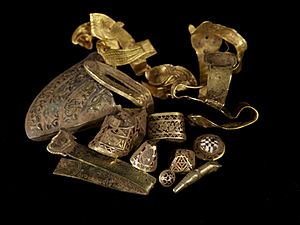
The first cathedral was built in 700 AD to hold St Chad's bones, which became a popular place for pilgrims. Kings of Mercia were also buried there, making the city even more important. For a short time, Lichfield was even an archbishopric, meaning it had authority over many other bishops. However, this power didn't last long.
During the 800s, Danish Vikings attacked Mercia. Lichfield wasn't protected by walls, and the cathedral was damaged. Because of this, the bishop moved the main church to Chester in 1075. Lichfield was just a small village in 1086.
Work on the current beautiful Gothic cathedral began in 1195. In 1153, King Stephen allowed Lichfield to have weekly markets, which have continued ever since.
Bishop Roger de Clinton helped shape the city's layout, creating the street pattern we see today. He also built defenses around the cathedral area and the town. In 1291, a big fire destroyed most of the town, but the Cathedral and its close were safe.
The Early Modern Period
Big changes happened in Lichfield during the time of Henry VIII. The English Reformation meant that people stopped coming to St Chad's shrine, which hurt the city's economy. A plague in 1593 also caused many deaths.
Sadly, some people were executed for their beliefs during this time. The last public burning for heresy in England happened in Lichfield in 1612.


During the English Civil War, Lichfield was divided. Some supported the King, while most townsfolk supported Parliament. The cathedral area was fortified and fought over. It was damaged, including the central spire, but was later repaired.
From the 1650s, Lichfield became a busy stop for coaches traveling between London and Chester, making it a rich town. In the 1700s and early 1800s, it was a thriving coaching city and a hub for smart people. Samuel Johnson, David Garrick, and Erasmus Darwin lived there. Much of the city was rebuilt in the red-brick Georgian style you can still see today. The city also improved its sewers, paved streets, and added gas streetlights.
Recent History
The arrival of the Industrial Revolution and railways in 1837 changed Lichfield. It was no longer a main stop for coaches. While nearby Birmingham grew a lot, Lichfield stayed much the same.
New houses were built in the 1930s. During World War II, over 2,000 people from industrial areas came to Lichfield for safety. The city wasn't heavily bombed because it didn't have much heavy industry. After the war, more houses were built, and the city's population grew a lot.
Recently, there have been plans for new shopping and leisure areas. A new cinema is planned for the old Debenhams building.
How Lichfield is Governed
Local Government
For a long time, the Bishop of Lichfield was in charge of the city. But in 1548, Lichfield got its own local government. In 1553, Queen Mary I gave the city even more power, making it a separate county from Staffordshire until 1888.
Today, the Lichfield City Council has 28 members elected every four years. They represent six different areas of the city. The Mayor of Lichfield leads the council meetings. Lichfield is one of only 15 towns and cities in England and Wales that still has a Sheriff.
Members of Parliament
Lichfield has its own Member of Parliament (MP) who represents the area in the UK Parliament. The current MP for Lichfield is Dave Robertson, who became MP in the 2024 general election.
Lichfield's Location and Landscape
Lichfield is about 5.41 square miles (14.02 km2) in size. It's located in the West Midlands region of England, north of Birmingham. The city sits between the high ground of Cannock Chase to the west and the valleys of the Trent and Tame rivers to the east. The ground is mostly red sandstone, which you can see in many old buildings like Lichfield Cathedral.
The city slopes down from higher ground in the north-west to the area where the cathedral stands. There are also hills to the south and west.
Two streams flow into the city from the west, and they have been dammed to create two beautiful lakes: Minster Pool and Stowe Pool.
City Areas
Lichfield has several different areas, or suburbs, like Boley Park, Darwin Park, and Streethay. Darwin Park is a newer area with homes and community facilities. It's named after Erasmus Darwin, a famous scientist who lived in Lichfield.
People of Lichfield
In 2021, the population of Lichfield was 34,738. Most residents are white (96.5%) and Christian (66.5%). Many adults (51%) are married, and a large percentage (64%) are employed, with 21% retired. These numbers are generally higher than the national average for England.
| Year | 1685 | 1781 | 1801 | 1831 | 1901 | 1911 | 1921 | 1931 | 1951 | 1961 | 1971 | 1981 | 1991 | 2001 | 2011 | 2021 |
|---|---|---|---|---|---|---|---|---|---|---|---|---|---|---|---|---|
| Population | 3,040 | 3,555 | 4,840 | 6,252 | 7,900 | 8,616 | 8,393 | 8,507 | 10,260 | 14,090 | 22,660 | 25,400 | 28,666 | 27,900 | 32,219 | 34,738 |
| %± | - | 16.9% | 36.1% | 29.2% | 26.4% | 9.1% | -2.6% | 1.35% | 19.1% | 37.3% | 60.8% | 12.1% | 12.9% | -2.7% | 15.5% | 7.8% |
Lichfield's Economy
Lichfield's economy grew because it was an important religious center. Pilgrims visiting St Chad's shrine brought wealth to the city until the Reformation.
In the Middle Ages, Lichfield was known for making woollen cloth and leather goods. The area around the city had many farms.
In the 1700s, Lichfield became a busy coaching center. This meant many inns and businesses like coach builders and saddlers thrived. When railways arrived, coach travel declined, and so did Lichfield's prosperity. By the late 1800s, brewing was the main industry, and local farms supplied food to nearby cities.
Today, Lichfield has several light industrial areas. Two well-known local companies are Armitage Shanks, which makes baths and showers, and Arthur Price of England, known for cutlery. Many people who live in Lichfield travel to Birmingham for work.
Culture and Community in Lichfield
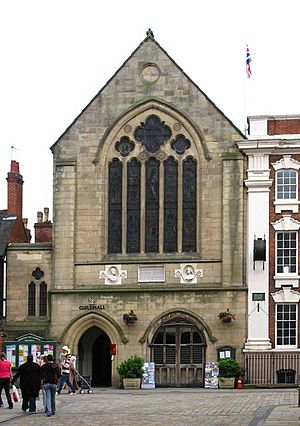
Festivals and Events
The Lichfield Greenhill Bower is an annual festival held on Spring Bank Holiday. It's a very old tradition that includes a procession with marching bands and carnival floats. A Bower Queen is crowned, and there are funfairs in the city center and Beacon Park.
The Lichfield Festival is an international arts festival that happens every July. It celebrates classical music, dance, drama, and more, with events at the cathedral and the Garrick Theatre. A popular part is the medieval market and fireworks display.
Every three years, the Lichfield Mysteries take place. This is a huge community theater event with over 600 amateur actors performing medieval-style plays at the cathedral and Market Place. Other summer festivals include the Lichfield Folk Festival and the Real Ale, Jazz and Blues Festival.
Lichfield Heritage Weekend, which includes Dr Johnson's Birthday Celebrations, happens in September. It features live music and free historical tours.
Community Places
Lichfield has many parks and open spaces. Beacon Park in the city center hosts many events. There are also two lakes, Minster Pool and Stowe Pool. The Garden of Remembrance is a memorial garden created after World War I.
For sports and fun, there's Friary Grange Leisure Centre and King Edward VI Leisure Centre, offering swimming, racket sports, and gyms.
The Lichfield Library and Record Office is located in the renovated St Mary's church on Market Square.
The city's hospital is the Samuel Johnson Community Hospital on Trent Valley Road.
Media
Local news and TV shows for Lichfield come from BBC West Midlands and ITV Central. You can listen to local radio stations like BBC Radio WM and Capital Mid-Counties. Local newspapers include the Lichfield Mercury and Lichfield Live.
Places to Visit in Lichfield
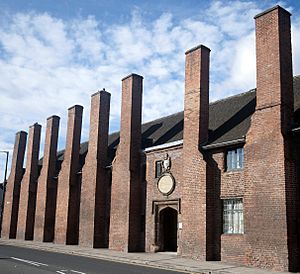
- Lichfield Cathedral - The only medieval cathedral in Europe with three spires. It was started in 1195.
- Cathedral Close - The area around the cathedral with many interesting old buildings.
- Samuel Johnson Birthplace Museum - A museum about the life of Samuel Johnson.
- Erasmus Darwin House - The home of Erasmus Darwin, now a museum.
- The Hub at St Mary's - Located in St Mary's Church, it's a community center and event space that also has the local library.
- Lichfield Guildhall - A historic building in the city center that has been used for city government for over 600 years.
- Bishop's Palace - Built in 1687, it was once the bishop's home and is now used by the Cathedral School.
- Hospital of St John Baptist without the Barrs - A unique Tudor building with eight brick chimneys, built to house travelers. It now provides homes for elderly people.
- Church of St Chad - A 12th-century church. Nearby is a reconstruction of 'St Chad's Well', where St Chad is said to have prayed.
- St Michael on Greenhill - An old churchyard overlooking the city, one of the largest in the country.
- The Market Square - In the city center, with statues of Samuel Johnson and his friend James Boswell.
- Beacon Park - A large public park used for sports and fun.
- Minster Pool & Stowe Pool - Two lakes in the heart of Lichfield. Stowe Pool is special because it's home to native White-Clawed Crayfish.
- The Franciscan Friary - The ruins of an old friary, now a protected ancient monument.
- Letocetum - The remains of a Roman stopping point and bath house, located south of the city.
- Staffordshire Regiment Museum - East of the city, this museum covers the history of the Staffordshire Regiment, with uniforms, weapons, and a replica World War I trench.
- National Memorial Arboretum - North-east of the city, a national site of remembrance with many memorials to the armed services.
Getting Around Lichfield
Trains
Lichfield has two train stations: Lichfield City and Lichfield Trent Valley. Both are on the Cross-City Line, with regular trains to Birmingham and other towns.
Trent Valley station is also on the West Coast Main Line, offering faster services to London Euston, which can take just over an hour.
Buses
Several bus companies operate in Lichfield, providing regular services to nearby towns like Birmingham, Tamworth, and Walsall. The main bus station is on Birmingham Road. There are also special bus services for college students and school children.
Roads
Lichfield is well-connected by roads. The old Roman roads, Watling Street and Ryknild Street, are now part of the A5 and A38 highways. The A5 goes west towards Wales, and the A38 goes south to Birmingham and north to Derby. The A51 road runs along the west side of the city.
The nearest motorway is the M6 Toll, just 2 miles (3 km) south of the city.
Canals
The Lichfield Canal was once part of the Wyrley and Essington Canal. It was closed in 1955 but there are plans to restore it. The nearest working canal is the Coventry Canal, which runs through Streethay.
Airports
Two airports are close to Lichfield: Birmingham Airport (20 miles/32 km south) and East Midlands Airport (34 miles/55 km north-east).
Education in Lichfield
Lichfield has nine primary schools and one infant school. There are also three secondary schools:
- The Friary School
- King Edward VI School
- Nether Stowe School
Two independent schools are also in the city:
- Lichfield Cathedral School: For ages 3 to 18.
- Maple Hayes School: A special school for children with dyslexia.
The Lichfield campus of Staffordshire University and South Staffordshire College offers college and university courses, including master's degrees. A new school for art, design, and media opened in 2006.
Religion and Beliefs
| Religion | Percentage of population |
|---|---|
| Buddhist | 0.3% |
| Christian | 66.5% |
| Hindu | 0.3% |
| Jewish | 0.1% |
| Muslim | 0.6% |
| Sikh | 0.1% |
| No religion | 24.9% |
| No answer | 6.8% |
In the 2011 Census, about 66.5% of people in Lichfield identified as Christian. Lichfield has been important for religion since St Chad built a monastery there in 669 AD.
Most churches in Lichfield are Anglican, including the cathedral. There are also two Roman Catholic churches, a Methodist church, and a United Reformed and Baptist church.
There are five faith-based primary schools in the city, including Church of England and Roman Catholic schools.
Sports in Lichfield
Historically, rugby was more popular than football in Lichfield. Both sports are played at an amateur level. Lichfield Rugby Union Football Club was founded in 1874.
Lichfield City is the local football club, with teams for all ages. Lichfield Diamonds LFC is a girls' football club.
Lichfield Cricket Club plays in the Birmingham and District Premier League. Lichfield Hockey Club also plays at the Collins Hill Sports Ground.
Lichfield has four golf courses, including one at Beacon Park. Lichfield Archers is an archery club with indoor and outdoor ranges.
Famous People from Lichfield
Many interesting people have come from Lichfield:
- Elias Ashmole (1617–1692), a collector and founder of the Ashmolean Museum.
- Gregory King (1648–1712), a genealogist and statistician.
- Joseph Addison (1672–1719), a famous essayist and poet.
- Samuel Johnson (1709–1784), the famous writer and dictionary maker.
- David Garrick (1717–1779), a well-known actor and theatre manager.
- Erasmus Darwin (1731–1802), a scientist, inventor, and grandfather of Charles Darwin.
- Anna Seward (1742–1809), a romantic poet.
- Henry Salt (1780–1827), an antiquarian who gave Egyptian items to the British Museum.
- Richard Garnett (1835–1906), a scholar and poet.
- Tony Christie (born 1943), a singer.
- Helen Baxendale (born 1970), an actress.
- Siobhan Dillon (born 1984), a singer and actress.
- Robert Rock (born 1977), a professional golfer.
- Freya Gregory (born 2003), a footballer.
Sister Cities
After World War II, Lichfield became twinned with two cities to help build friendships between nations:
- Limburg an der Lahn, Germany
- Sainte-Foy-lès-Lyon, France
See also
 In Spanish: Lichfield para niños
In Spanish: Lichfield para niños
- Bishops of Lichfield
- Lichfield Canal
- The Lichfield Gospels
- RAF Lichfield


